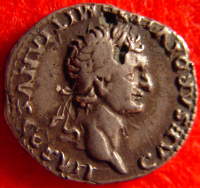Coins of the United States dollar - aside from those of the earlier Continental currency - were first minted in 1792. New coins have been produced annually and they comprise a significant aspect of the United States currency system. Circulating coins exist in denominations of 1¢, 5¢, 10¢, 25¢, 50¢, and $1.00. Also minted are bullion, including gold, silver and platinum, and commemorative coins. All of these are produced by the United States Mint. The coins are then sold to Federal Reserve Banks which in turn put coins into circulation and withdraw them as demanded by the United States economy.
There are eight euro coin denominations, ranging from one cent to two euros. The coins first came into use in 2002. They have a common reverse, portraying a map of Europe, but each country in the eurozone has its own design on the obverse, which means that each coin has a variety of different designs in circulation at once. Four European microstates that are not members of the European Union use the euro as their currency and also have the right to mint coins with their own designs on the obverse side.

1943 steel cents are U.S. one-cent coins that were struck in steel due to wartime shortages of copper. The Philadelphia, Denver, and San Francisco mints each produced these 1943 Lincoln cents. The unique composition of the coin has led to various nicknames, such as wartime cent, steel war penny, zinc cent and steelie. The 1943 steel cent features the same Victor David Brenner design for the Lincoln cent which had been in use since 1909.
Mint-made errors occur when coins are made incorrectly at the mint, including anything that happens to the coin up until the completion of the minting process. Mint error coins can be the result of deterioration of the minting equipment, accidents or malfunctions during the minting process, or interventions by mint personnel. Coins are inspected during production and errors are typically caught. However, some are inadvertently released into circulation. Modern production methods eliminate many errors and automated counters are effective at removing error coins. Damage occurring later may sometime resemble true mint errors. Error coins may be of value to collectors depending on the rarity and condition. Some coin collectors specialize in error coins.

A nickel is a five-cent coin struck by the United States Mint. Composed of cupronickel, the piece has been issued since 1866. Its diameter is 0.835 inches (21.21 mm) and its thickness is 0.077 inches (1.95 mm).

The United States Mint is a bureau of the Department of the Treasury responsible for producing coinage for the United States to conduct its trade and commerce, as well as controlling the movement of bullion. The U.S. Mint is one of two U.S. agencies that produce money in the case of minting coinage; the other is the Bureau of Engraving and Printing, which prints paper currency. The first United States Mint was created in Philadelphia in 1792, and soon joined by other centers, whose coins were identified by their own mint marks. There are currently four active coin-producing mints: Philadelphia, Denver, San Francisco, and West Point.
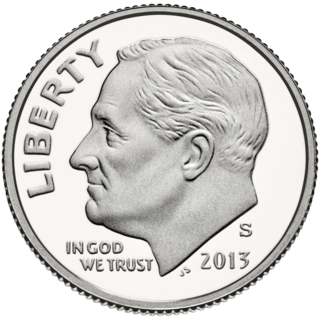
The dime, in United States usage, is a ten-cent coin, one tenth of a United States dollar, labeled formally as "one dime". The denomination was first authorized by the Coinage Act of 1792.
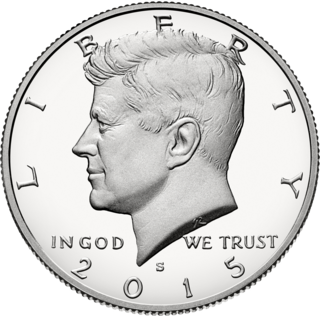
The half dollar, sometimes referred to as the half for short or 50-cent piece, is a United States coin worth 50 cents, or one half of a dollar. In both size and weight, it is the largest United States circulating coin currently produced, being 1.205 inches in diameter and 0.085 in (2.16 mm) in thickness, and is twice the weight of the quarter. The coin's design has undergone a number of changes throughout its history. Since 1964, the half dollar depicts the profile of President John F. Kennedy on the obverse and the seal of the president of the United States on the reverse.
A circulation issue or circulation coin, sometimes called a business strike (US), is a coin minted and issued for commerce as opposed to those made as commemorative coins and proof coins. Circulation issue coins are normally produced in relatively large numbers, and are primarily meant to be used as pocket change, not collected. But after their withdrawal from circulation, these coins are highly valued by collectors, especially coins of high quality and without traces of use in trade. Preserved circulation coins are one of the primary sources by which scientists reconstruct the culture, history, and society of the time in which they were used.
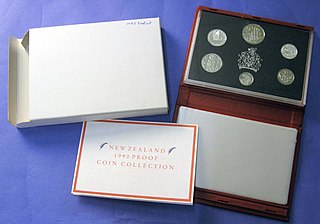
Proof coinage refers to special early samples of a coin issue, historically made for checking the dies and for archival purposes. Nowadays proofs are often struck in greater numbers specially for coin collectors (numismatists). Nearly all countries have issued proof coinage.
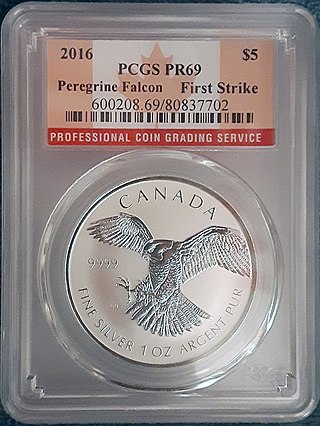
Coin grading is the process of determining the grade or condition of a coin, one of the key factors in determining its collectible value. A coin's grade is generally determined by six criteria: strike, preservation, luster, color, attractiveness, and occasionally the country/state in which it was minted. Several grading systems have been developed. Certification services professionally grade coins for tiered fees.
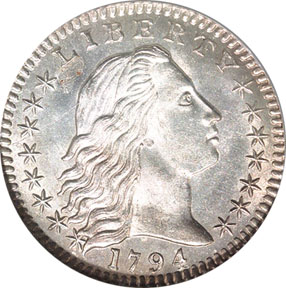
The half dime, or half disme, was a silver coin, valued at five cents, formerly minted in the United States.

The Mercury dime is a ten-cent coin struck by the United States Mint from late 1916 to 1945. Designed by Adolph Weinman and also referred to as the Winged Liberty Head dime, it gained its common name because the obverse depiction of a young Liberty, identifiable by her winged Phrygian cap, was confused with the Roman god Mercury. Weinman is believed to have used Elsie Stevens, the wife of lawyer and poet Wallace Stevens, as a model. The coin's reverse depicts a fasces, symbolizing unity and strength, and an olive branch, signifying peace.

Numismatic Guaranty Company (NGC) is an international third-party coin grading and certification service based in Sarasota, Florida. It has certified more than 60 million coins. NGC certification consists of authentication, grading, attribution, and encapsulation in clear plastic holders. NGC is a subsidiary of Certified Collectibles Group (CCG), which owns six collectible certification services and is in turn owned by Blackstone, a multibillion-dollar New York City hedge fund.

The 1 euro coin (€1) is a euro coin with a value of one euro. It is made of two alloys: the inner part of cupronickel, the outer part of nickel brass. All coins have a common reverse side and country-specific national sides. The coin has been used since 2002, with the present common side design dating from 2007.

Coin roll hunting is the hobby of searching and sorting coinage pulled from circulation for collectible coins. This is achieved through obtaining rolled coin, boxed coin, or bagged coin from banks and credit unions. A variant of this practice involves banknotes and is carried out in essentially the same fashion, normally to search for unusual serial numbers, star notes, and misprints.
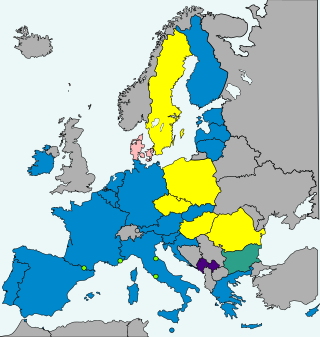
Gold and silver issues of the euro commemorative coins are collectors' euro coins not primarily intended for general circulation; the commemoratives also include rare cases of bimetal collector coins, such as titanium and niobium.
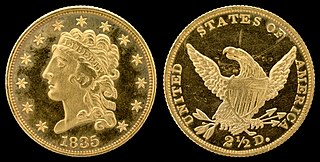
The Classic Head $2.50 gold coin is an American coin, also called a quarter eagle, minted from 1834 to 1839. It features Liberty on the obverse and an eagle on the reverse.
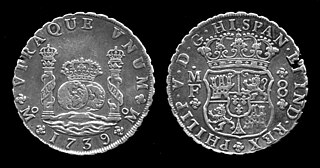
The numismatic history of the United States began with Colonial coins such as the pine tree shilling and paper money; most notably the foreign but widely accepted Spanish piece of eight, ultimately descended from the Joachimsthaler and the direct ancestor of the U.S. Dollar.

A gold coin is a coin that is made mostly or entirely of gold. Most gold coins minted since 1800 are 90–92% gold (22‑karat), while most of today's gold bullion coins are pure gold, such as the Britannia, Canadian Maple Leaf, and American Buffalo. Alloyed gold coins, like the American Gold Eagle and South African Krugerrand, are typically 91.7% gold by weight, with the remainder being silver and copper.
